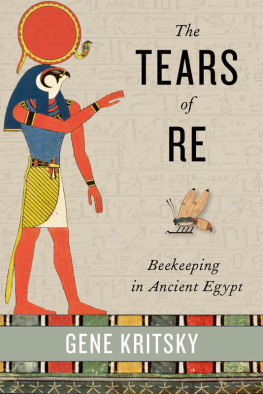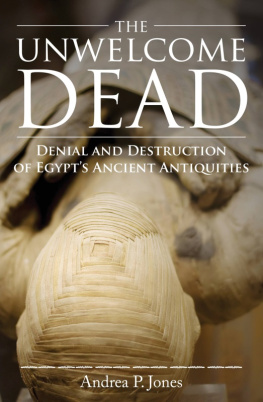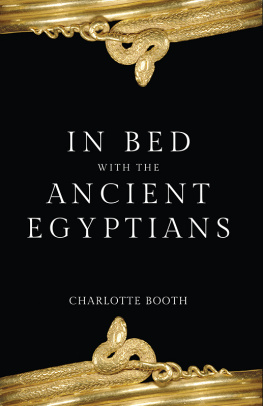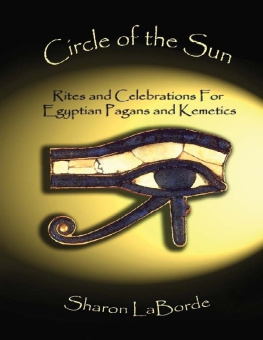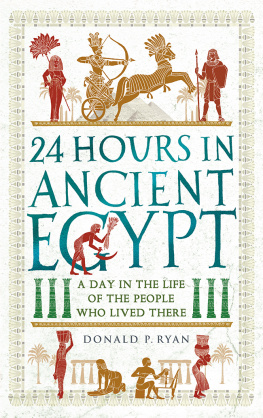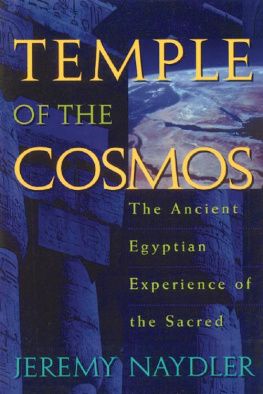
The Tears of Re

Oxford University Press is a department of the University of Oxford. It furthers the Universitys objective of excellence in research, scholarship, and education by publishing worldwide.
Oxford New York
Auckland Cape Town Dar es Salaam Hong Kong Karachi Kuala Lumpur Madrid Melbourne Mexico City Nairobi New Delhi Shanghai Taipei Toronto
With offices in
Argentina Austria Brazil Chile Czech Republic France Greece Guatemala Hungary Italy Japan Poland Portugal Singapore South Korea Switzerland Thailand Turkey Ukraine Vietnam
Oxford is a registered trade mark of Oxford University Press in the UK and certain other countries.
Published in the United States of America by
Oxford University Press
198 Madison Avenue, New York, NY 10016
Oxford University Press 2015
All rights reserved. No part of this publication may be reproduced, stored in a retrieval system, or transmitted, in any form or by any means, without the prior permission in writing of Oxford University Press, or as expressly permitted by law, by license, or under terms agreed with the appropriate reproduction rights organization. Inquiries concerning reproduction outside the scope of the above should be sent to the Rights Department, Oxford University Press, at the address above.
You must not circulate this work in any other form and you must impose this same condition on any acquirer.
Library of Congress Cataloging-in-Publication Data
Kritsky, Gene, author.
The tears of Re : beekeeping in ancient Egypt / Gene Kritsky
p.cm.
Includes bibliographical references and index.
ISBN 9780199361403
1. Bee cultureEgyptHistory. 2. HoneyEgyptHistory.
3. Bee productsEgyptHistory. I. Title. II. Title: Beekeeping in ancient Egypt.
SF531.E3K75 2015
638.10962dc23
2015020031
987654321
Printed in the United States of America on acid-free paper
This book is dedicated to the memory of Dr. Eva Crane.
Neolithic Period (55003100 BCE)
Dynasty 0 (31503050 BCE)
Early Dynastic Period
First Dynasty (c.30502850 BCE) [first honey bee hieroglyphs]
Second Dynasty (c.28502687 BCE)
Old Kingdom
Third Dynasty (c.26872649 BCE)
Fourth Dynasty (c.26492513 BCE)
Fifth Dynasty (c.25132374 BCE) [Newoserre Any relief, Unas relief]
Sixth Dynasty (c.23742191 BCE)
First Intermediate Period
Seventh Dynasty (c. 21902165 BCE)
Eighth Dynasty (c. 21902165 BCE)
Ninth Dynasty (c. 21652040 BCE)
Tenth Dynasty (c. 21652040 BCE)
Early Eleventh Dynasty (21342061 BCE)
Middle Kingdom
Late Eleventh Dynasty (20611991 BCE)
Twelfth Dynasty (19911786 BCE) [Senwosret III relief]
Thirteen and Fourteenth Dynasties (17861664 BCE)
Second Intermediate PeriodHyksos Occupation
Fifteenth Dynasty (c.16641555 BCE)
Sixteenth Dynasty (c.16651600 BCE)
Seventeenth Dynasty (c.16001569 BCE)
New Kingdom
Eighteenth Dynasty (c.15691315 BCE) [Amenhotep relief, Rekhmire painting]
Nineteenth Dynasty (13151201 BCE)
Twentieth Dynasty (c.12001081 BCE)
Third Intermediate Period
Twenty-first Dynasty (1081931 BCE)
Twenty-second Dynasty (931725 BCE)
Twenty-third Dynasty (c.813711 BCE)
Twenty-fourth Dynasty (724711 BCE)
Twenty-fifth Dynasty (c.755656 BCE) [Harwa cenotaph]
Late Period
Twenty-sixth DynastySaite Dynasty (664525 BCE) [Pabasa and Ankhhor tombs]
Twenty-seventh DynastyFirst Persian Occupation (525405 BCE)
Twenty-eighth Dynasty(405399 BCE)
Twenty-ninth Dynasty (399380 BCE)
Thirtieth Dynasty (380343 BCE)
Thirty-first DynastySecond Persian Occupation (343333 BCE)
Greco-Roman Period
Macedonian Dynasty (332305 BCE)
Ptolemaic Era (30531 BCE) [Edfu and Dendera honey offerings]
Roman Era (30 BCE337 CE)
The Ancient Egyptian Chronology was adapted from .
As a teenager, I happened upon some honeycomb that had fallen out of a tree near my home in south Florida. I collected the larvae and pupae from the sealed brood cells, placed them into test tubes, and watched them develop into mature beesan incredible metamorphosis that inspired my lifelong interest in bees and apiculture. My introduction to Egypt began just a few months before I discovered that comb, when I read a book on evolution. The book discussed Bishop Usshers chronology of the Bible; he calculated that the world was created in 4004 BCE, and that Noahs flood occurred in 2348 BCE. That seemed rather recent to me, so I began to explore ancient Egyptian history to see how it fit with Usshers chronology. It turned out that the pyramids were built before Usshers date for the flood, which seemed, to say the least, a bit surprising. To make sure that was true, I started reading a variety of books on Egyptian history and soon was captivated by Egyptian art, mythology, and technology.
My Egyptophilia was reinforced when the Tutankhamun exhibit toured the United States while I was an entomology graduate student at the University of Illinois. Between classes and research, I viewed the exhibit at the Field Museum in Chicago and attended several presentations at the University of Illinois Art Department on the history of Egyptology, and I made a promise to myself that I would go to Egypt within 10 years.
That promise came to fruition in only five years, when I received a Fulbright Scholarship to teach entomology at Minya University in Upper Egypt for the academic year of 19811982. During my year in Egypt, I visited 94 archaeological sites and even got locked inside an Egyptian tomb during a sandstorm.
In addition to exploring Egypts tombs and temples, I studied the role of insects, especially beetles, flies, and bees, in ancient Egyptian culture. After my return to the United States, I read wonderful book The Archaeology of Beekeeping, which opened my mind to the field of apicultural archaeology. My wife, Jessee, and I had the good fortune to visit Dr. Crane and her assistant Penny Walker at Dr. Cranes home at Gerrards Cross in Buckinghamshire, England, where we discussed our mutual interests in beekeeping history.
In 2006, I created a travel course to Egypt with my close friend Daniel Mader, an art history professor at Mount St. Joseph University. During our four trips to Egypt with students in tow, I arranged to visit several beekeeping-related sites, where I had the opportunity to make detailed examinations of many important reliefs. In addition to our travel to Egypt, Jessee and I embarked on a sabbatical tour of Europe and the United States in 2011, visiting museums that house important Egyptian collections. These endeavors were crucial in enabling me to complete this project.
A number of colleagues have assisted me in completing this project. Adela Oppenheim at the Metropolitan Museum of Art generously shared her discoveries with me and offered valuable insights that aided in interpreting some of the reliefs. Alice Stevenson arranged for me to examine potsherds and portraits from the Petrie Museum of Egyptian Archaeology at the University College London. David Smart at the Cleveland Museum of Art enabled me to examine the museums incredible collection of beeswax artifacts, and Elizabeth Saluk kindly provided the photographs of those objects.
Several individuals at the British Museum also offered indispensable help. I thank Daniel Antoine, Marie Vandenbeusch, and Marcel Mare in the Department of Ancient Egypt and Sudan for their assistance in examining and photographing items that were not on public display.
Next page
